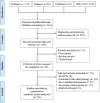Efficacy of stem cell therapy for burn wounds: a systematic review and meta-analysis of preclinical studies
- PMID: 32727568
- PMCID: PMC7389817
- DOI: 10.1186/s13287-020-01839-9
Efficacy of stem cell therapy for burn wounds: a systematic review and meta-analysis of preclinical studies
Abstract
Background: Burns remain a serious public health problem with high morbidity and mortality rates worldwide. Although there are various treatment options available, there is no consensus on the best treatment for severe burns as of yet. Stem cell therapy has a bright prospect in many preclinical studies of burn wounds. The systematic review was performed for these preclinical studies to assess the efficacy and possible mechanisms of stem cells in treating burn wounds.
Methods: Twenty-two studies with 595 animals were identified by searching PubMed, EMBASE, Web of Science, and Cochrane Library databases from inception to 13 May 2020. In addition, a manual search of references of studies was performed to obtain potential studies. No language or time restrictions were enforced. RevMan 5.3 was used for all data analysis.
Results: The overall meta-analysis showed that stem cell therapy significantly improved burn healing rate (SMD 3.06, 95% CI 1.98 to 4.14), irrespective of transplant type, burn area, and treatment method in the control group. Subgroup analyses indicated that hair follicle stem cells seemed to exert more beneficial effects on animals with burn wounds (SMD 7.53, 95% CI 3.11 to 11.95) compared with other stem cells. Furthermore, stem cell therapy seemed to exert more beneficial effects on burn wounds with second-degree (SMD 7.53, 95% CI 3.11 to 11.95) compared with third-degree (SMD 2.65, 95% CI 1.31 to 4.00).
Conclusions: Meta-analysis showed that stem cell therapy exerts a healing function for burn wounds, mainly through angiogenesis and anti-inflammatory actions. These findings also demonstrate the need for considering variations in future clinical studies using stem cells to treat a burn wound in order to maximize the effectiveness. In general, stem cells can potentially become a novel therapy candidate for burn wounds.
Keywords: Burns; Meta-analysis; Preclinical study; Stem cell therapy; Wound healing.
Conflict of interest statement
The authors declare that they have no competing interests.
Figures





Similar articles
-
Efficacy assessment of mesenchymal stem cell transplantation for burn wounds in animals: a systematic review.Stem Cell Res Ther. 2020 Aug 28;11(1):372. doi: 10.1186/s13287-020-01879-1. Stem Cell Res Ther. 2020. PMID: 32859266 Free PMC article. Review.
-
Efficacy of autologous platelet-rich plasma in treating patients with burn wounds: A protocol for systematic review and meta-analysis.Medicine (Baltimore). 2021 Apr 30;100(17):e25650. doi: 10.1097/MD.0000000000025650. Medicine (Baltimore). 2021. PMID: 33907125 Free PMC article.
-
Antiseptics for burns.Cochrane Database Syst Rev. 2017 Jul 12;7(7):CD011821. doi: 10.1002/14651858.CD011821.pub2. Cochrane Database Syst Rev. 2017. PMID: 28700086 Free PMC article. Review.
-
Systematic Review of Stem-Cell-Based Therapy of Burn Wounds: Lessons Learned from Animal and Clinical Studies.Cells. 2020 Nov 26;9(12):2545. doi: 10.3390/cells9122545. Cells. 2020. PMID: 33256038 Free PMC article.
-
Clinical therapeutic effects of platelet-rich plasma in patients with burn wound healing: A protocol for systematic review and meta-analysis.Medicine (Baltimore). 2021 Aug 6;100(31):e26404. doi: 10.1097/MD.0000000000026404. Medicine (Baltimore). 2021. PMID: 34397792 Free PMC article.
Cited by
-
Recent advances in nanotherapeutics for the treatment of burn wounds.Burns Trauma. 2021 Sep 25;9:tkab026. doi: 10.1093/burnst/tkab026. eCollection 2021. Burns Trauma. 2021. PMID: 34778468 Free PMC article. Review.
-
A single-center, open-labeled, randomized, 6-month, parallel-group study to assess the safety and efficacy of allogeneic cultured keratinocyte sheet transplantation for deep second-degree burn wounds: rationale and design of phase I/II clinical trial.Trials. 2024 Apr 1;25(1):226. doi: 10.1186/s13063-024-08070-4. Trials. 2024. PMID: 38556879 Free PMC article. Clinical Trial.
-
Association between vitamin D deficiency and diabetic foot ulcer wound in diabetic subjects: A meta-analysis.Int Wound J. 2023 Jan;20(1):55-62. doi: 10.1111/iwj.13836. Epub 2022 May 14. Int Wound J. 2023. PMID: 35567425 Free PMC article.
-
Promotion of Burn Wound Healing by Local Application of Adipose-Derived Mesenchymal Stem Cells: An Experimental Study.Med J Islam Repub Iran. 2021 Dec 22;35:172. doi: 10.47176/.35.172. eCollection 2021. Med J Islam Repub Iran. 2021. PMID: 35685200 Free PMC article.
-
Mesenchymal Stem Cells in Burn Wound Management.Int J Mol Sci. 2022 Dec 5;23(23):15339. doi: 10.3390/ijms232315339. Int J Mol Sci. 2022. PMID: 36499664 Free PMC article. Review.
References
-
- Peck MD. Epidemiology of burns throughout the world. Part I: Distribution and risk factors. Burns. 2011;37(7):1087–1100. - PubMed
Publication types
MeSH terms
Substances
LinkOut - more resources
Full Text Sources
Medical

